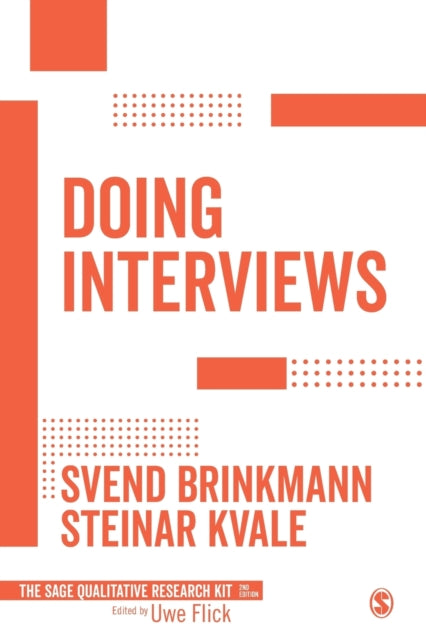Svend Brinkmann,Steinar Kvale
Doing Interviews
Doing Interviews
YOU SAVE £2.34
- Condition: Brand new
- UK Delivery times: Usually arrives within 2 - 3 working days
- UK Shipping: Fee starts at £2.39. Subject to product weight & dimension
Bulk ordering. Want 15 or more copies? Get a personalised quote and bigger discounts. Learn more about bulk orders.
Couldn't load pickup availability
- More about Doing Interviews
A concise introduction to the richness and scope of interviewing in social science research, teaching the craft of interview research with practical, hands-on guidance.
Format: Paperback / softback
Length: 208 pages
Publication date: 13 October 2018
Publisher: SAGE Publications Ltd
This comprehensive guide delves into the depth and versatility of interviewing in social science research, equipping readers with practical skills and hands-on guidance to excel in interview-based research. By exploring a wide range of methods employed in interview-based studies and discussing effective approaches to analyzing the collected data, this book empowers researchers to confidently navigate the diverse field of qualitative research. Whether you are a novice or an experienced researcher, this book serves as a valuable resource for collecting and interpreting qualitative data, enabling you to make meaningful contributions to your field.
INTRODUCTION
Interviewing is a fundamental research method in social science, allowing researchers to gather firsthand information from individuals or groups about their experiences, perspectives, and behaviors. It offers a rich source of data that can provide valuable insights into complex social phenomena and help to develop theories and hypotheses. In this comprehensive guide, we will explore the richness and scope of interviewing in social science research, teaching you the craft of interview research with practical, hands-on guidance.
WHAT IS INTERVIEWING?
Interviewing is a structured conversation between a researcher and a respondent, typically conducted in person or over the phone. It involves a series of questions designed to elicit information about a particular topic or issue. Interviews can be conducted in a variety of settings, including homes, schools, workplaces, and community centers, and can last anywhere from a few minutes to several hours.
WHY IS INTERVIEWING IMPORTANT?
Interviewing is important because it allows researchers to gain access to a wide range of perspectives and experiences that may not be available through other research methods. It can provide insights into the thoughts, feelings, and behaviors of individuals and groups, which can help to develop a more nuanced understanding of social phenomena. Additionally, interviews can be used to test hypotheses and validate theories, providing empirical evidence to support or refute them.
TYPES OF INTERVIEWS
There are several types of interviews used in social science research, including structured interviews, semi-structured interviews, and unstructured interviews. Structured interviews involve a set of pre-determined questions that are asked in a standardized manner to all respondents. Semi-structured interviews involve a set of questions that are open-ended and allow respondents to provide more detailed responses. Unstructured interviews involve a free-flowing conversation between the researcher and the respondent, which allows for more in-depth exploration of topics.
APPROACHES TO INTERVIEWING
There are several approaches to interviewing, including the phenomenological approach, the interpretive approach, and the critical approach. The phenomenological approach focuses on the subjective experiences of individuals and groups, seeking to understand their perceptions, beliefs, and attitudes. The interpretive approach focuses on the meanings that individuals and groups assign to their experiences, seeking to understand the social and cultural contexts in which they occur. The critical approach focuses on the power dynamics and inequalities that shape individuals and groups' experiences, seeking to challenge dominant narratives and promote social justice.
READING THE DATA
Reading the data collected from interviews is a critical step in the research process. It involves analyzing the transcripts of the interviews, identifying themes and patterns, and drawing conclusions about the research question. There are several methods used to analyze interview data, including content analysis, thematic analysis, and discourse analysis.
CONCLUSION
Interviewing is a powerful research method that can provide valuable insights into social science research. By exploring the wide variety of methods in interview-based research and the different approaches to reading the data, this book will help you to navigate the broad field of qualitative research with confidence and get out there and start collecting your data. Whether you are a novice or an experienced researcher, this book serves as a valuable resource for collecting and interpreting qualitative data, enabling you to make meaningful contributions to your field.
Weight: 328g
Dimension: 156 x 233 x 12 (mm)
ISBN-13: 9781473912953
Edition number: 2 Revised edition
This item can be found in:
UK and International shipping information
UK and International shipping information
UK Delivery and returns information:
- Delivery within 2 - 3 days when ordering in the UK.
- Shipping fee for UK customers from £2.39. Fully tracked shipping service available.
- Returns policy: Return within 30 days of receipt for full refund.
International deliveries:
Shulph Ink now ships to Australia, Belgium, Canada, France, Germany, Ireland, Italy, India, Luxembourg Saudi Arabia, Singapore, Spain, Netherlands, New Zealand, United Arab Emirates, United States of America.
- Delivery times: within 5 - 10 days for international orders.
- Shipping fee: charges vary for overseas orders. Only tracked services are available for most international orders. Some countries have untracked shipping options.
- Customs charges: If ordering to addresses outside the United Kingdom, you may or may not incur additional customs and duties fees during local delivery.


